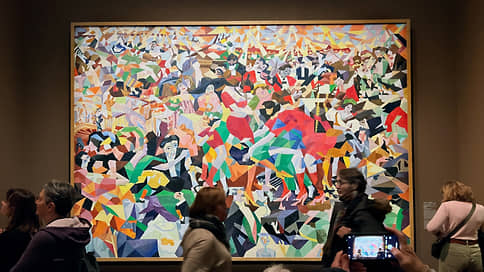Petit Palais completes the trilogy of exhibitions with “Modern Paris” 1905–1925
[ad_1]

The Museum of Modern Art of Paris continues a series of exhibitions that tell the story of how the great city became the world’s artistic capital. After “Romantic Paris” and “Paris of the 1900s,” Petit Palais completes the trilogy with 1905–1925 “Modern Paris.” Kommersant correspondent in France reports Alexey Tarkhanov.
In the years 1905–1925, a lot was happening in Paris and in world art. From the first lawless artistic communes of Montparnasse and Montmartre, with the “clever rabbit” on the sign of the Lapin Agile cabaret (first exhibit), to the majestic sculptures of the 1925 Decorative Arts Exhibition (last hall). She introduced Art Deco to the world and paved the way for both the fascist and Nazi architecture of Mussolini and Hitler, as well as the Soviet “Stalinist style”. And in the middle – 1914-1918 – the years of the World War, which killed and maimed millions of people, including the artists of this exhibition. But if the war ended the Belle Epoque, it did not prevent the birth of the Roaring Twenties.
Of course, the organizers could not do without Hemingway’s quote about “a holiday that is always with you” and did not leave it without visual illustrations. The symbol of the raging Parisian fun – the huge colored patchwork canvas of the Italian futurist Gino Severini “Pan-Pan Dance in Monico” – is echoed by the incredible theatrical productions of the “city-play” such as the costumes of “Parade” by Satie-Cocteau-Picasso or Léger’s sets for “The Creation of the World” . Nearby, in the famous photo of Man Ray “Adam and Eve,” Marcel Duchamp and young fashion model Bronya Perlmutter, a friend of Rene Clair, are posing naked. The original by Lucas Cranach the Elder is dated 1528, the photograph is from 1924, we are talking about the re-creation of the world, which constantly took place in Paris, where Fauvism was pursued by surrealism, Dadaism, futurism, constructivism, and then everywhere else.
The exhibition does not forget foreigners who have become part of France: Maria Vasilyeva, Igor Stravinsky (not only the portrait, but also the music of “The Rite of Spring” playing in the hall), Tamara Karsavina in a dance from “The Firebird” in a painting by Jacques-Émile Blanche and Olga Khokhlova in the “Picasso corner”. In a place of honor is Konstantin Melnikov’s Parisian pavilion from the 1925 exhibition, accompanied by flattering reviews from Le Corbusier, Perret and Mallet-Stevens. The excellent sculptures of the Ukrainian Jew Hana Orlova bring back to us this outstanding artist, who was almost erased from memory by the forced immigration of World War II.
Foreign artists gratefully remember the call issued during the First World War to join the French army, where the Pole Guillaume Apollinaire was wounded in the head, the Swiss Blaise Cendrars lost an arm, and the Belarusian Jew Ossip Zadkine was gassed. Skepticism about the euphoria of war did not prevent them from viewing the four years of battle as a source of extraordinary experience. The vaccination against official patriotism was done conscientiously – as can be seen in the soldier’s overcoat designed by the “king of fashion” Paul Poiret, and the Senegalese shooters freezing in the snow in the painting by Felix Vallotton, and the fanfare “Patriotic Dolls” by Jacqueline Marval and even the Cartier “Triumphal” brooch arch”, where sapphire cabochons depict blue soldiers’ helmets.
Tommaso Marinetti, who published his manifesto of futurism in France, assured that the car “cannot be compared in beauty to the Nike of Samothrace.” His thesis is illustrated at the exhibition by the Deperdussin airplane from the Aviation Museum, a Peugeot car and even a folding bicycle. A reminder of the horsepower hidden in engines – the star-shaped aircraft engine is echoed by the futuristic “Horse” by Raymond Duchamp-Villon. But Marcel Duchamp’s mocking “Bicycle Wheel” standing next to it speaks of a completely different view of this gasoline-soaked culture.
The exhibition ends in 1925, when Paris again, as in 1900, became the “capital of the world” and a supplier of freely convertible artistic images. Like the projects of Paul Landowski, the French Vuchetich, who supplied the world with his monumental sculptures – the Wall of the Reformation in Geneva or Christ in Rio de Janeiro – to the envy of Speer and Iofan. The halls of the Petit Palais say everything about this time: here there is fashion, cinema, photography, painting, sculpture, music, dance, design, architecture. But the main lesson that can be learned by carefully examining almost four hundred amazing exhibits is this. Modernity is not achieved through suffering, modernity is born through fun.
You can talk as much as you like about how poor, even beggars, the artists were who came to the shadow of the Eiffel Tower (from the poster for the current exhibition, which reproduces Robert Delaunay’s “Woman and the Tower” from 1925), but they were not coming for torment, they were looking for freedom. They fled here from the Pale of Settlement, like Chagall or Soutine, from Prohibition and triumphant bigotry, like Hemingway and Fitzgerald, from apartheid, like the black woman Josephine Baker, from all the stupid religious, racial, gender and sexual prohibitions that are in the artistic In Paris in those years they spat from a high tower. And even now, a hundred years later, this is the only path to modernity.
[ad_2]
Source link






